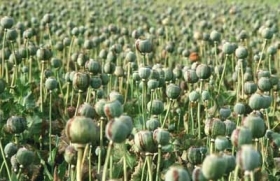The discovery of an illicit poppy field in Ecuador draws attention to increasing production of heroin in Latin America, with the crop moving into new territories like Guatemala.
On November 19, Ecuadorean police officers encountered a relatively rare sight in the South American country: a poppy field covering 12 acres in the central province of Cotopaxi. Officials destroyed the crops, but made no arrests.
Although not noteworthy for its size (officials estimate that the field would have produced just one kilogram of heroin), the find is unusual in Ecuador. The country is known more as a transit point for heroin from Colombia than as a source of the drug. As Flavio Mirella, the UNODC specialist on Ecuador noted recently, “The incidence [of poppy plantations] is in its infancy, it is not remarkably widespread.”
However, recent data suggests this may be changing, with poppy cultivation becoming increasingly common across the region. According to the United Nations Office on Drugs and Crime’s (UNODC) 2011 World Drug Report, the total potential for processed opium in Latin America rose by more than 450 percent in just five years, going from 95 metric tons in 2005 to 434 in 2010.
The vast majority of this increase is due to reported changes in heroin production in Mexico. Although Mexican officials dispute this, both United States and UN drug experts say that Mexican cartels have funded a surge in poppy cultivation in the country. The UNODC estimated that a net 19,500 hectares were used to grow poppy in 2009, up from just 3,300 in 2005. Perhaps the most well-known example of this involves the Sinaloa Cartel, which has sponsored a boom of small-scale poppy farming in the “Golden Triangle” states of Sinaloa, Durango and Chihuahua.
Meanwhile, Colombia, the other major powerhouse of illicit drug production in the hemisphere, has seen a dramatic reduction in heroin production over the past decade. From 2005 to 2009, the estimated total for poppy cultivation fell from 1,950 hectares to 356. Like the country’s sizeable reduction in coca cultivation, this is due at least in part to heightened security crackdowns and an increase in eradication programs.
But poppy production in Latin America is not limited to these two countries alone. Guatemala is also becoming a significant site of poppy cultivation. In its latest International Narcotics Control Strategy Report, the U.S. Department of State claimed that there was “increasing prevalence and organization of poppy cultivation” in Guatemala. While there have been no reliable estimates on how much is produced in the country, the Guatemalan government reported eradicating 1,134 hectares in 2009. As InSight Crime has noted, this is more than the poppy eradication in Colombia for that year (1,100 hectares). This, combined with the fact that the Guatemalan government has not monitored poppy cultivation as thoroughly as the Colombians, suggests that the Central American country may be home to even more.
Of course, the main market for the products of Latin America’s illicit poppy cultivation is the United States. While the exact numbers are not available, the U.S. Department of Justice’s 2011 National Drug Threat Assessment notes that nearly all of the heroin available in the U.S. is trafficked by Mexican, Colombian, or Dominican groups. That being said, local demand for heroin is increasing throughout the region, especially in urban centers. This trend is only likely to worsen as production continues to rise, and as Mexico continues its crackdown on drug trafficking groups, potentially forcing Mexican cartels to seek new markets for heroin in the region.
However, it’s worth noting that, according to the most recent UN estimates, the heroin production of Latin America is dwarfed by that of Asia. Latin America produces less than 450 metric tons of dried product a year, compared to 4,000 for Southwest and Southeast Asia combined.

